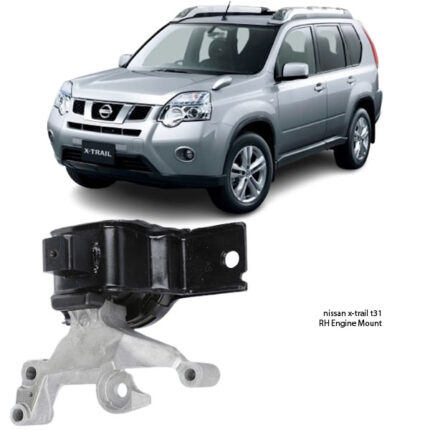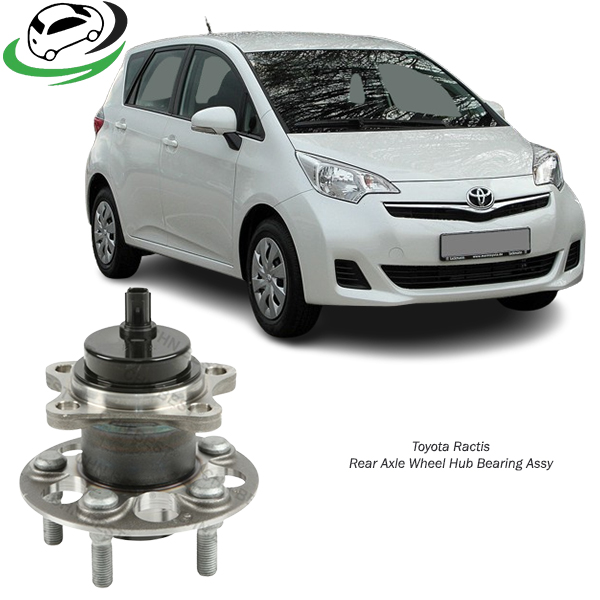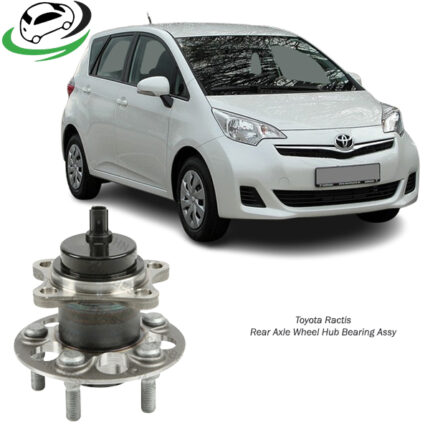-7%
Get Toyota Ractis Rear Axle Wheel Hub Bearing Assy 42450-52100 in Kenya
The rear axle wheel hub bearing assembly is an essential component of a vehicle’s drivetrain and suspension system, directly contributing to safe, smooth, and efficient operation. Its primary role is to allow the wheel to rotate with minimal friction, supporting the vehicle’s weight and providing stability. This component combines the wheel hub and bearing into a single assembly, which simplifies installation and maintenance. In this detailed exploration, we’ll cover the structure, function, benefits, common issues, and maintenance practices for the rear axle wheel hub bearing assembly.
1. Structure of the Rear Axle Wheel Hub Bearing Assembly
The rear axle wheel hub bearing assembly is a pre-assembled unit that consists of multiple key components:
- Wheel Hub: This central part of the assembly is where the wheel attaches. It has studs on which the wheel is mounted, providing the basis for the connection between the wheel and the vehicle’s suspension.
- Bearing: The bearing inside the hub is typically a ball or roller bearing, which reduces friction and supports smooth wheel rotation. It contains an outer and inner race with rolling elements in between, held together with a cage to ensure uniform spacing.
- ABS Sensor (in some models): In vehicles with anti-lock braking systems (ABS), the wheel hub bearing assembly may have a built-in sensor to monitor wheel speed. This sensor provides data to the ABS control unit, preventing wheel lock-up during braking.
- Seal: This is a protective element that shields the bearing from dirt, moisture, and other contaminants. Proper sealing is crucial as it prevents contamination and helps retain lubricants within the bearing, extending its lifespan.
The assembly is secured to the rear axle and may vary slightly in design, depending on the vehicle’s make and model. However, all rear axle wheel hub bearing assemblies share these core features, combining the hub and bearing into a single, cohesive unit.
2. Function of the Rear Axle Wheel Hub Bearing Assembly
The rear axle wheel hub bearing assembly serves multiple important functions within the vehicle’s drivetrain and suspension system.
a. Facilitating Wheel Rotation
The main function of the assembly is to enable smooth and efficient rotation of the rear wheels. The bearing’s low-friction design allows the wheel to rotate freely while carrying the vehicle’s weight. This function is crucial for maintaining fuel efficiency, as excess friction would require more power to rotate the wheels.
b. Supporting Vehicle Weight
The wheel hub and bearing assembly bears a significant portion of the vehicle’s weight. It distributes this load across the axle while allowing for consistent and stable movement, especially on uneven or rough terrain. This balance of weight-bearing and rotational ability is essential for a comfortable ride.
c. Enhancing Stability and Control
By securely holding the wheel in place, the hub bearing assembly plays a direct role in vehicle stability. It minimizes lateral wheel movement, ensuring the wheel remains aligned with the axle, which helps the driver maintain control during turns, braking, and acceleration.
d. Interfacing with the ABS System
In vehicles equipped with ABS, the wheel hub bearing assembly often includes a speed sensor that provides real-time wheel speed data. This data is critical to the ABS system’s ability to modulate brake pressure and prevent wheel lock-up, especially during emergency braking.
3. Benefits of a High-Quality Rear Axle Wheel Hub Bearing Assembly
A well-maintained and high-quality wheel hub bearing assembly provides several benefits that enhance the performance, safety, and longevity of the vehicle.
a. Improved Ride Comfort
A properly functioning hub bearing assembly reduces friction and allows for smooth wheel rotation. This smooth operation minimizes vibrations and noise, leading to a quieter and more comfortable ride, especially at higher speeds.
b. Enhanced Fuel Efficiency
With low friction in the bearing, the vehicle can maintain optimal fuel efficiency. High-quality bearings are designed to reduce resistance, requiring less power to turn the wheels and thereby conserving fuel.
c. Increased Safety
A high-quality wheel hub bearing assembly contributes to vehicle stability and control, which is essential for safe driving. Furthermore, if equipped with an ABS sensor, the assembly assists in providing accurate data to the braking system, enhancing braking effectiveness and preventing wheel lock-up during emergency stops.
d. Longevity of Related Components
By reducing vibrations and supporting balanced wheel rotation, the rear axle hub bearing assembly prevents undue wear on other suspension and drivetrain components. This benefit extends the overall lifespan of the vehicle and lowers maintenance costs over time.
4. Common Issues and Symptoms of a Worn Rear Axle Wheel Hub Bearing Assembly
Like any mechanical part, the rear axle wheel hub bearing assembly is subject to wear and eventual failure. Recognizing the signs of a worn or failing assembly is crucial to maintaining vehicle safety and performance. Some common symptoms and issues include:
a. Grinding or Growling Noise
One of the most common symptoms of a failing wheel hub bearing is a grinding or growling noise coming from the wheel area, especially during acceleration or deceleration. This noise indicates that the bearing has worn down and may be caused by friction between damaged rolling elements within the bearing.
b. Excessive Play or Wobble in the Wheel
A worn wheel hub bearing can cause excessive play or wobble in the wheel, compromising vehicle stability and increasing the risk of an accident. A technician can diagnose this issue by testing the wheel’s lateral movement while the vehicle is lifted.
c. ABS Warning Light
In vehicles with an ABS system, a malfunctioning wheel hub bearing assembly can trigger the ABS warning light. If the ABS sensor within the hub fails, it may prevent the ABS system from accurately monitoring wheel speed, leading to compromised braking performance.
d. Uneven Tire Wear
A failing wheel hub bearing assembly can cause the wheel to move out of alignment, resulting in uneven tire wear. This uneven wear pattern is often a sign that the wheel is not rotating smoothly, which can increase the risk of blowouts or other tire-related issues.
e. Vibration in the Steering Wheel
Although more common with front-wheel bearings, a failing rear axle bearing can still cause vibrations that may be felt in the steering wheel. This vibration typically worsens at higher speeds or during turns.
5. Maintenance and Replacement of the Rear Axle Wheel Hub Bearing Assembly
Routine maintenance and timely replacement are key to ensuring the longevity and performance of the rear axle wheel hub bearing assembly. Here are some practical tips:
a. Regular Inspections
Regular inspection of the wheel hub bearing assembly is essential, especially during routine maintenance visits. A visual inspection for signs of rust, corrosion, or physical damage can reveal potential issues before they escalate.
b. Monitoring for Symptoms
Listening for unusual noises, such as grinding or humming sounds from the wheels, can alert you to potential bearing issues early. Addressing these symptoms promptly can prevent further damage to the hub and suspension system.
c. Timely Replacement
A damaged or failing wheel hub bearing assembly should be replaced as soon as possible. Waiting too long can lead to additional damage to nearby components and create a safety hazard. Replacement typically involves removing the wheel, braking components, and old hub assembly before installing a new unit.
d. High-Quality Parts
When replacing the rear axle wheel hub bearing assembly, it’s advisable to use high-quality, OEM or equivalent parts. Higher-quality assemblies often feature better materials and manufacturing standards, which enhances durability and performance.
e. Professional Installation Recommended
Installing a new wheel hub bearing assembly can be complex, especially if it involves an ABS sensor. Professional installation ensures the assembly is installed correctly, minimizing the risk of premature failure and ensuring proper functionality.
Conclusion
The rear axle wheel hub bearing assembly plays a pivotal role in a vehicle’s performance, stability, and safety. It allows smooth wheel rotation, supports the vehicle’s weight, and, in some cases, interacts with the ABS system to enhance braking effectiveness. A high-quality hub bearing assembly reduces friction, minimizes wear on suspension components, and ensures optimal handling. Regular inspections, symptom monitoring, and timely replacement are essential for maintaining this component’s performance and extending its lifespan. Recognizing the signs of a failing hub bearing assembly and opting for quality replacements are essential steps for any vehicle owner, as they contribute to a safer, more comfortable, and cost-effective driving experience.
Follow us on Facebook for more parts.




